Chess Notes
Edward Winter
When contacting us by e-mail, correspondents are asked to include their name and full postal address and, when providing information, to quote exact book and magazine sources. The word ‘chess’ needs to appear in the subject-line or in the message itself.
| First column | << previous | Archives [151] | next >> | Current column |
10327. The Mac Lopez
On page 164 of the Illustrated London News, 23 July 1955 B.H. Wood referred to ‘the “Mac-Lopez” – that deliciously-coined title for the variation of the Ruy Lopez which resembles the Scotch Game’.
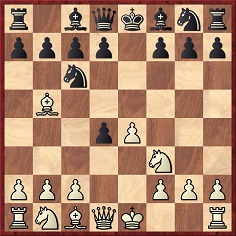
Position after 1 e4 e5 2 Nf3 Nc6 3 d4 exd4 4 Bb5
From page 167 of 500 Master Games of Chess by S. Tartakower and J. du Mont (London, 1952):
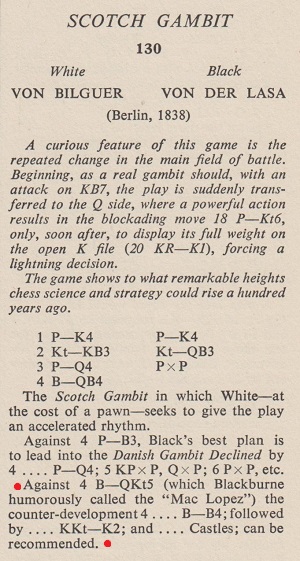
Blackburne mentioned his remark in a note after 4 Bb5 on page 443 of the November 1904 BCM (in a game against W.C. Palmer in the British Championship Tournament at Hastings, 1904):
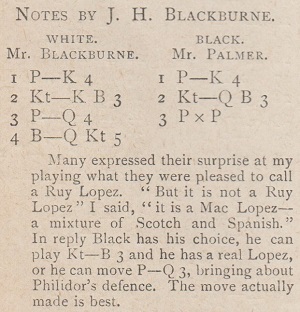
When the game was published on pages 359-360 of the Deutsche Schachzeitung, December 1904, reference was made to a game between Lange and Schierstädt (sic) in 1857 (sic):

That well-known Max Lange brilliancy was included on, for instance, pages 10-12 of The King-Hunt by W.H. Cozens (London, 1970), where Black was identified as von Schierstedt and the heading was ‘Exhibition Game, about 1856’. Various anything-will-do databases state – categorically, of course – either 1856 or 1857, without any venue, but when Max Lange himself annotated the game on pages 112-115 of his book Sammlung Neuer Schachpartien (Leipzig, 1857) he gave Black’s name as Herr von Schierstedt, with the information ‘gespielt zu Wörmlitz am 1. März 1855’.
In connection with another familiar (capped knight) game, see C.N. 3502 for a reference to ‘Fräulein Jenny von Schierstedt’.
10328. Carl F. Jaenisch (C.N. 10323)
Michael Negele (Wuppertal, Germany) reports that an article of his about Jaenisch on page 8 of the 3/2015 issue of KARL noted that F. stood for Ferdinand and not, as used to be believed, Friedrich. Our correspondent also provides links to three webpages: IOS, e3 e5 and FamilySearch.
10329. George Alan Thomas
Page 69 of the American Chess World, March 1901:

Page 94 of the April 1901 issue had a correction to problem 36 (the rook on g7 should be black), but it is problem 35, an intricate self-mate in five, that is of particular interest. Was it by George Alan Thomas?
The dearth of compositions by him was mentioned on page 32 of Leonard Barden’s Chess Puzzle Book (London, 1977), a collection of Evening Standard columns:
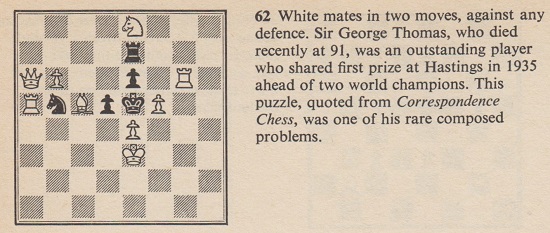
The problem’s appearance in Correspondence Chess, Autumn 1972, page 324, is shown below, courtesy of the Cleveland Public Library:
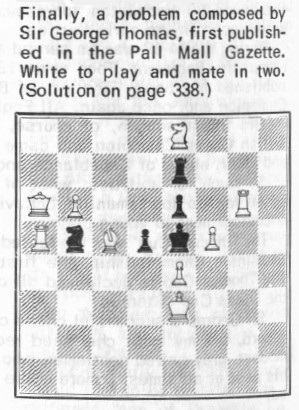
From page 9 of the Pall Mall Gazette, 15 March 1897:
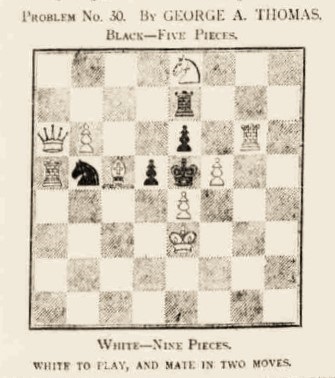
The solution was published on page 9 of the 22 March 1897 edition.
The article ‘A Great British Sportsman’ by Mrs Jean Rogers on pages 323-324 of the above-mentioned issue of Correspondence Chess included a postal game which he won against W.J., with notes by Gunsberg from the Penny Illustrated Paper, 13 November 1897:
1 d4 f5 2 c4 Nf6 3 Nc3 e6 4 a3 c6 5 Bg5 Be7 6 e3 a6 7 Nf3 O-O 8 Bd3 Ne8 9 Bf4 d6 10 h3 Nd7 11 Qc2 Rf7 12 O-O-O Nf8 13 g4 Ng6 14 Ne2 Bd7 15 gxf5 exf5 16 Rdg1 Nxf4 17 Nxf4 Bh4 18 c5 Bf6 19 h4 d5 20 h5 Qc7 21 h6 g6
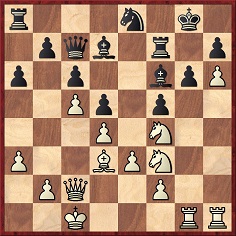
22 Bxf5 Bxf5 23 Qxf5 Bxd4 24 Rxg6+ Kh8 25 Rhg1 Bxb2+ 26 Kxb2 hxg6 27 Nxg6+ Resigns.
We have not seen that issue of the Penny Illustrated Paper but can show another early game won by Thomas, aged 15, against A.C. Jackman, from page 9 of the Pall Mall Gazette, 8 February 1897:
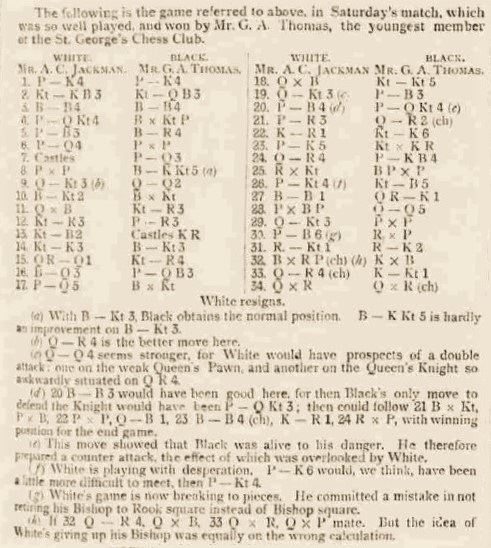
The game was played in an 11-board match on 6 February 1897 at the St George’s Chess Club in London between that Club and a North London team.
1 e4 e5 2 Nf3 Nc6 3 Bc4 Bc5 4 b4 Bxb4 5 c3 Ba5 6 d4 exd4 7 O-O d6 8 cxd4 Bg4 9 Qb3 Qd7 10 Bb2 Bxf3 11 Qxf3 Nh6 12 Na3 a6 13 Nc2 O-O 14 Ne3 Bb6 15 Rad1 Na5 16 Bd3 c6 17 d5 Bxe3 18 Qxe3 Ng4 19 Qg3 f6 20 f4
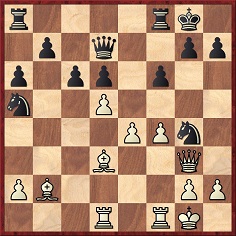
20...b5 21 h3 Qa7+ 22 Kh1 Ne3 23 e5 Nxf1 24 Qh4 f5 25 Rxf1 cxd5 26 g4 Nc4 27 Bc1 Rae8 28 gxf5 Qd4 29 Qg3 dxe5 30 f6 Rxf6 31 Rg1 Re7 32 Bxh7+ Kxh7 33 Qh4+ Kg8 34 Qxf6 Qxg1+ 35 White resigns.
10330. Havana, 1913
Capablanca’s book on Havana, 1913 (Torneo internacional de ajedrez) has been reprinted by Ishi Press International, though not from the original. As shown by, for instance, the handwritten markings on page 35, the Google scan freely available online has been used. The group photograph on the front cover is our scan from the original book, as given in the feature article on Juan Corzo.
The ‘Introduction by Sam Sloan’ – which comes towards the end (pages 119-121) – begins:
‘This book is remarkable because is [sic] was unknown or almost completely unknown until it was discovered by Stuart Dill.’
The next sentence states that Capablanca also wrote ‘A Premier of Chess’.
Two of the three pages comprising the Introduction are merely about Abraham Kupchik. Then come two pages of biographical notes about the eight contestants (‘Compiled by crawfb5 Larry Crawford on chessgames.com’).
The back cover has a crass blurb in Spanish, with the accent on the -ish, which concludes:

To revert to the first quote above, the claim about Stuart Dill’s supposed discovery is inexplicable, as the Havana, 1913 book was already well known before the Ishi hash. The original Cuban edition has been reprinted in recent years by Moravian Chess (undated). In 1978 a reset Spanish version was published by Radio Rebelde, Havana. In addition to the 1976 English translation by Edward Invierno, there is an Italian edition, by Piero Angelini and Maurizio Martelli (Rome, 2003).
10331. Pillsbury blindfold games
Eduardo Bauzá Mercére (New York, NY, USA) has sent this cutting from page 12 of the Chicago Tribune, 1 March 1903:

1 e4 e5 2 Nf3 Nc6 3 Bb5 a6 4 Ba4 Nf6 5 O-O Be7 6 Nc3 d6 7 Bxc6+ bxc6 8 d4 Nd7 9 dxe5 dxe5 10 Qe2 Bf6 11 Qc4 Bb7 12 Rd1 Qe7 13 Be3 O-O 14 Na4 Rfe8 15 Bc5 Nxc5 16 Nxc5 Bc8 17 Rd3 Rd8 18 Rad1 Rd6 19 Qa4 Bd7 20 Qa5 Bc8 21 Qd2 Rb8
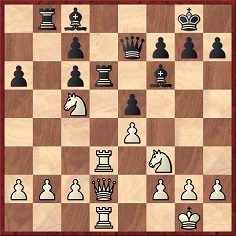
22 b4 Rxd3 23 Nxd3 Bg4 24 Nc5 a5 25 a3 axb4 26 axb4 Bxf3 27 gxf3 Bg5 28 Qd7 Rd8 29 Qxd8+ Qxd8 30 Rxd8+ Bxd8 31 Nd7 f6 32 Nb8 c5 33 Nc6 Resigns.
1 e4 e5 2 Nf3 Nc6 3 Bb5 Nf6 4 O-O Nxe4 5 d4 Nd6 6 Bxc6 dxc6 7 dxe5 Nf5 8 Qxd8+ Kxd8 9 Rd1+ Ke8 10 Nbd2 h6 11 b3 Be6 12 c4 Rd8 13 Bb2 Bb4 14 Ne4 a5 15 Rxd8+ Kxd8 16 g4 Ne7
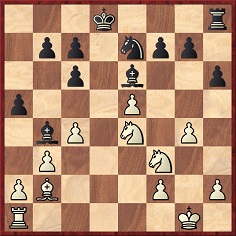
17 a3 Bxg4 18 Nd4 c5 19 Nb5 Bf3 20 axb4 Bxe4 21 bxc5 Nc6 22 Bc3 b6 23 cxb6 cxb6 24 Nd6 Bg6 25 f4 Ke7 26 f5 Bh5 27 Kf2 f6 28 c5 bxc5 29 Nc4 fxe5 30 Nxe5 Nxe5 31 Bxe5 Rf8 32 Bxg7 Rxf5+ 33 Ke1 Rg5 34 Bc3 Bf7 35 Rxa5 Bxb3 36 Ra7+ Ke8 37 Rh7 h5 38 h4 Rf5 39 Bd2 Bf7 40 Bg5 Kd7 41 Rh6 c4 42 Kd2 Rf3 43 Kc2 Rg3 44 Rd6+ Drawn.
Our correspondent notes that the ten-board blindfold display in Berlin took place on 23 December 1902, as reported on page 429 of Deutsches Wochenschach, 28 December 1902. The spelling of the Black allies’ names is to be noted.

[Addition on 16 February 2017: see too C.N. 10342 below.]
10332. Candidates’ tournament, Yugoslavia, 1959
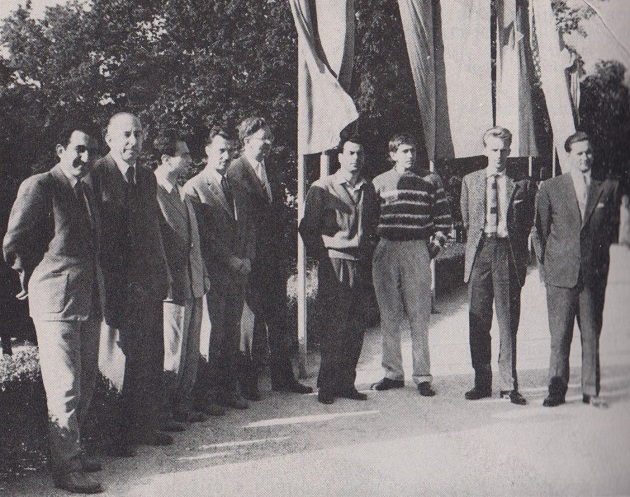
From left to right: Petrosian, Golombek (chief arbiter), Tal, Gligorić, Smyslov, Benko, Fischer, Ólafsson, Keres.
Source: Chess Review, December 1959, page 360. A less clear copy of the picture is opposite the imprint page of Kandidatenturnier für Schachweltmeisterschaft by S. Gligorić and V. Ragozin (Belgrade, 1960) with the caption ‘Alle Spieler mit grossen Hoffnungen: Vor dem Turnierbeginn in Bled’.
10333. Taffs and Penrose
Two problems submitted by Michael McDowell (Westcliff-on-sea, England):

Mate in two
Source: the Observer, 6 June 1926, page 25. Mr McDowell reports that this was the first problem by A.J. Taffs, who was then aged ten, and he also provides a link to the webpage Taffs Music. For more information about Taffs see C.N.s 303, 374, 4181 and 4186.
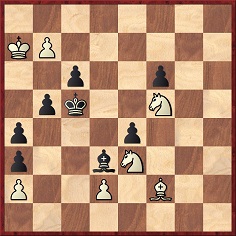
Mate in three
The composer was Jonathan Penrose. Source: Manchester Guardian, 26 May 1958.
10334. Thomas v W.J. (C.N. 10329)
The request for Gunsberg’s column in the Penny Illustrated Paper, 13 November 1897 has been answered by Roger Watson (Dewsbury, England). It was on page 309:

10335. Emanuel Lasker

The Factfinder contains many references to the books based on the chess collection of David DeLucia, and the latest, compiled by his son John, is a 711-page hardback on Emanuel Lasker. It includes an absorbing range of letters, articles, photographs and ephemera, most previously unseen, and the production standards are unsurpassable.
10336. Highland Queen whisky
Further to Chess in Advertisements and Chess and Alcohol, Olimpiu G. Urcan (Singapore) has forwarded some mid-1930s advertisements for Highland Queen whisky:
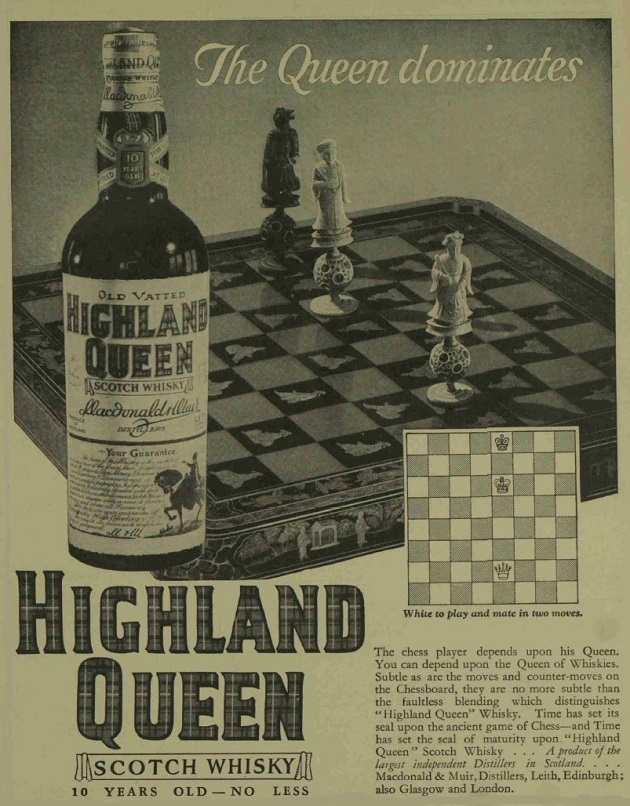
Illustrated London News, 20 July 1935, page 4
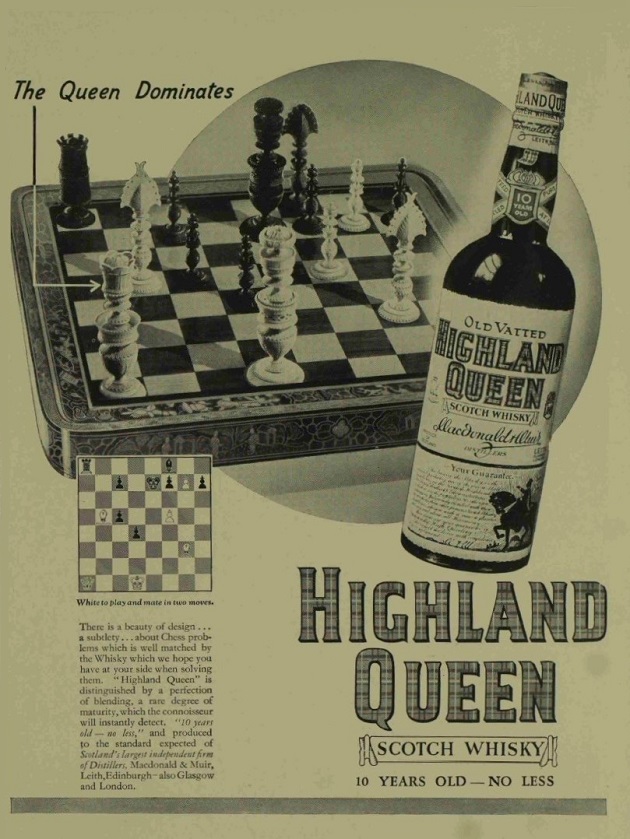
Illustrated London News, 7 December 1935, page 3, and The Sphere, 14 March 1936, page 466
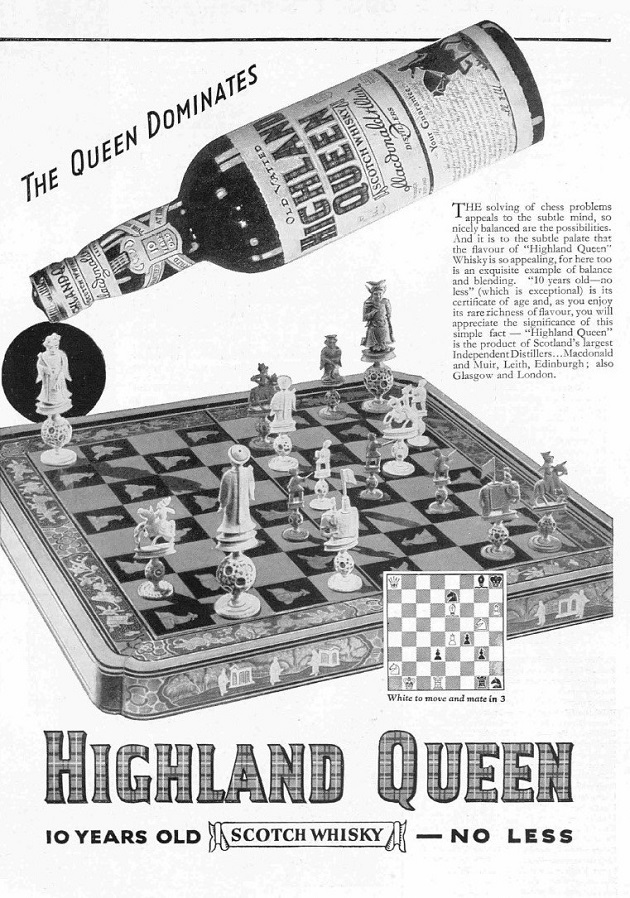
The Sphere, 14 December 1935, page 447
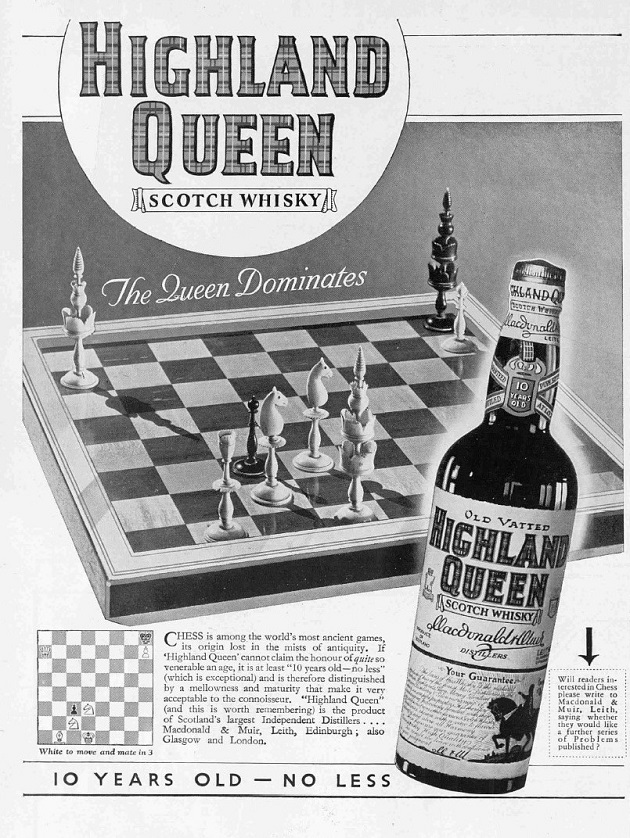
The Sphere, 11 April 1936, page 80.
A future item will discuss the chess problems.
10337. Capablanca on R.H.V. Scott
From page 2 of the October 1920 Chess Amateur:
‘Mr W. [sic – V.] L. Wahltuch writes in Manchester Weekly Times that, after the Hastings Congress last year, Mr Capablanca remarked of Mr R.H.V. Scott, who has now achieved the highest honour in British chess: “Mr Scott is decidedly an aggressive player, and if success depended on a bold attack or sacrifice he could certainly be counted upon to obtain it. His manner of play, however, is decidedly wrong, as he often sacrifices material without sufficient cause, and frequently when it is quite unnecessary for the purpose of achieving success. I fear that unless he completely changes his style he will not progress far.” We have not seen many of the games Mr Scott played at Edinburgh, so cannot express any opinion as to whether he has “changed his style”. His performance is a good one, as the competitors were a good lot ...’
In its report on Scott’s victory in the British championship in Edinburgh, page 306 of the October 1920 BCM commented:
‘Scott has an excellent “nose” for attack and has some exceedingly “chessy” ideas. During the Congress he put a much greater restraint on himself than is his wont, and we believe this to be the reason he so improved on his previous records.’
The frontispiece of that issue of the BCM:
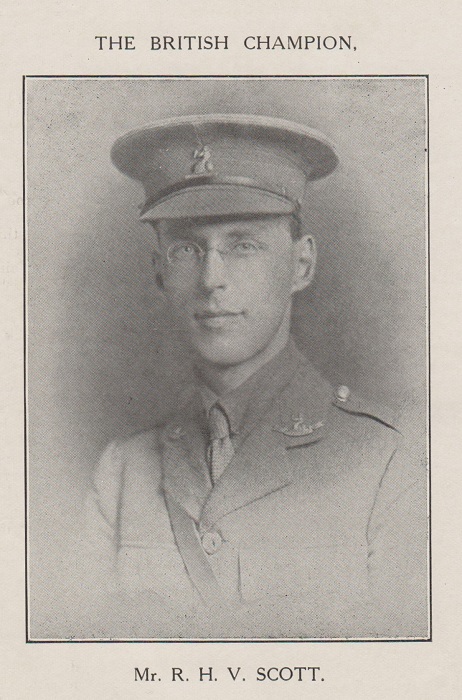
If a reader can trace the above-mentioned Manchester Weekly Times item, we shall be grateful. Information is also sought on the circumstances and context of Capablanca’s observations.
Together with Capablanca and Scott, Wahltuch was a participant in Hastings, 1919. From his obituary on pages 270-271 of the October 1953 BCM:
‘Here he refused the offer of a draw from Capablanca (later to be godfather of his third daughter), and in trying to win he lost a game of 51 moves. Against the other prizewinners (these included Kostić) he drew.’
10338. Identification
Guy Gignac (Donnacona, Canada) seeks information about this photograph which he owns (and, particularly, positive identification of Marcel Duchamp on the right):
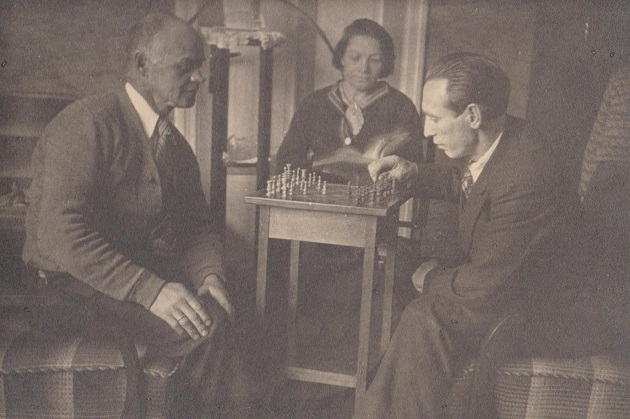
10339. Spassky v Fischer, 1972 (C.N. 9761)
Noting another novel featuring the 1972 world championship match, Åttenderaden by Arne Danielsen (Oslo, 2002 and 2014), Aðalsteinn Thorarensen (Reykjavik) comments:
‘The main character is Herold, who grows up in Oslo, and there is a great deal of chess content (at school and in junior tournaments). Herold follows Bobby Fischer’s career and by chance is in Iceland for a club event during the Spassky v Fischer world title match.’
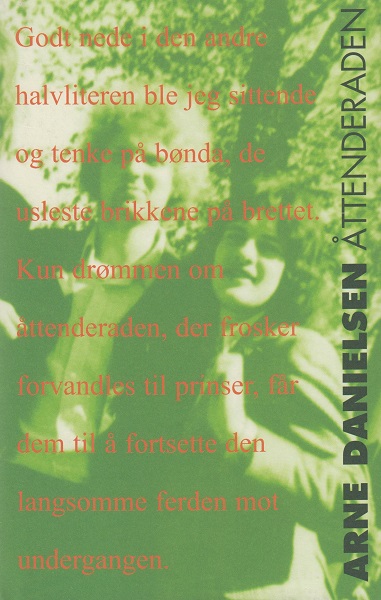
The original hardback edition (2002)
Danielsen is also the author of Mesteren Magnus Carlsen og sjakkspillet (Oslo, 2010). From the dust-jacket:
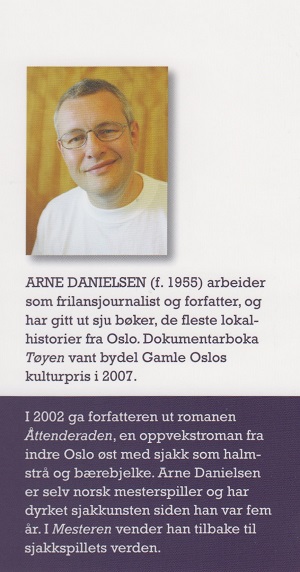
10340. Comments by Spassky
Two remarks by Spassky quoted in an interview/article by Grant Segall on pages 1E and 5E of the Sun-Sentinel (Florida), 8 August 1985:
- ‘I always have a lack of the killer instinct. I love chess, but I hate it as a profession. You must kill your opponent. I just want to reflect myself on the board.’
- [Alluding to Shakespeare] ‘In my life, I have many stages. I was dying from hunger. I was beaten by people. Then I had glamour, I had money, I became a millionaire. I missed only one [of the seven stages the Bard describes]: participating in the war. But two divorces – this is participating in the war.’
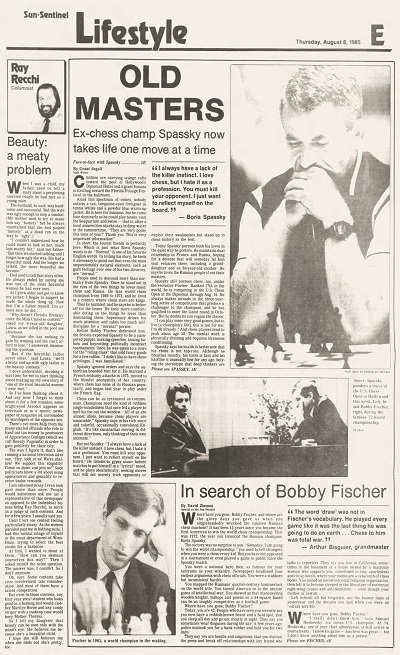
The full article is available online: part one; part two.
10341. Réti
All too often, it seems, authors of the ‘move by move’ books (Everyman Chess) have been recruited for their availability rather than suitability – most notably, the unshakeably available Cyrus Lakdawala – but Réti move by move by Thomas Engqvist (London, 2017) is one of the better volumes in the series and, in principle, Engqvist was a reasonable choice for such a book.

Even so, the prose, and especially in the eight-page Introduction, often strays from natural English (page 13: ‘... you are actually playing according in a hypermodern fashion’), and, in common with his ‘move by move’ predecessors, the author was unwise not to enlist the help of a chess historian. The relatively extensive, though basic, bibliography (pages 4-6) includes Fischer move by move by the afore-ridiculed Cyrus Lakdawala but mentions only one periodical, Tidskrift för Schack (two issues, published in 1920 and 2016).
The first diagram (Introduction, page 9) gives the source of Réti’s most famous endgame study as ‘Kagan’s Neueste Schachnachrichten, 1921’, a mistake also found, for instance, on page 61 of Réti’s Best Games of Chess by Harry Golombek (London, 1954).
Réti wrote about the study in a letter to Bernhard Kagan on page 171 of Kagan’s Neueste Schachnachrichten, April 1922:
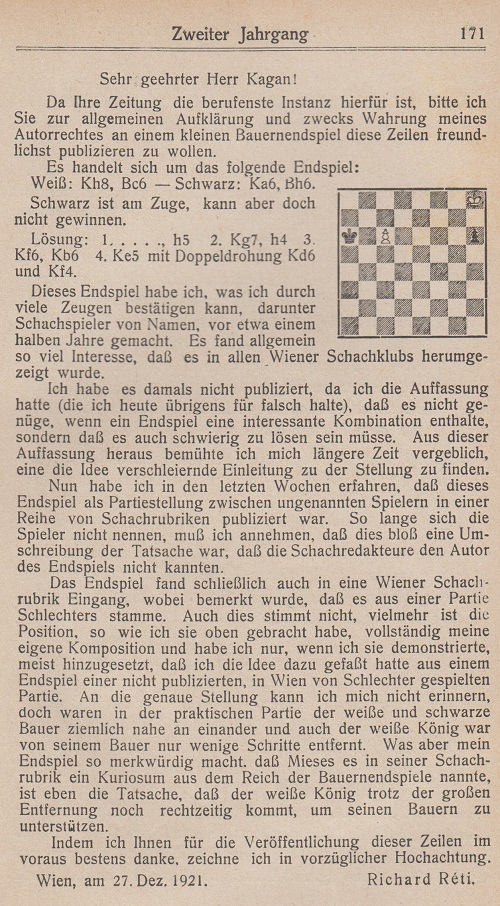
However, the position had appeared in other publications in 1921, as related, for instance, in the BCM in 1990 (February, page 73; April, page 176; June, page 268; September, page 411). See too the article ‘Reti-Manöver oder Marco-Manöver?’ by J. Selman in Schach-Echo (18/1967, page 278; 20/1967, pages 309-310; 22/1967, pages 340-341; 23/1967, pages 356-357; 2/1968, pages 23-25).
An indispensable source concerning Réti’s life, games and compositions (with correct information on the above study) is Richard Réti, šachový myslitel by Jan Kalendovský (Prague, 1989). There exists too an Italian edition, by Fabio Molin, Reti poesia del paradosso (Rome, 2003):
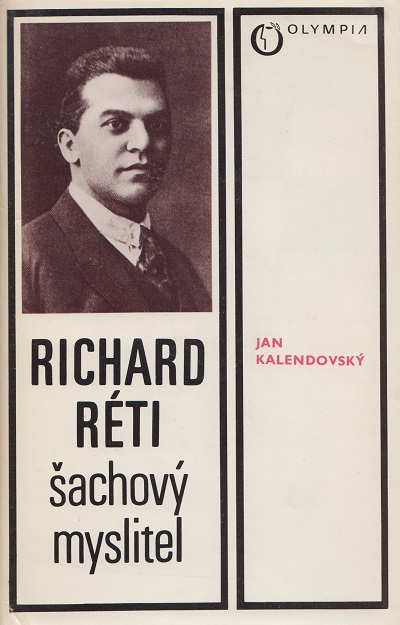
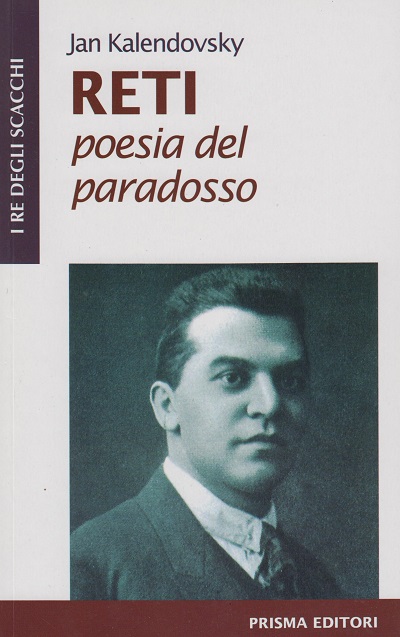
Over 50 books are listed in the bibliography of Réti move by move, including Engqvist’s own ‘move by move’ volumes on Petrosian and Stein, but Jan Kalendovský’s name appears nowhere. Engqvist nonetheless writes on page 12:
‘Why there are so few books about Réti, who is as significant a player as such other non-world champions such [sic] as Nimzowitsch and Rubinstein, remains an enigma.’
10342. Pillsbury (C.N. 10331)
From Peter Anderberg (Harmstorf, Germany):
‘The games in question were played over the board, and not blindfold. Pillsbury gave two displays, the first on 22 December 1902 (15 blindfold games) and the second on 23 December 1902 (ten consultation games over the board). “Während er bei den Blindpartien wie immer den Anzug hatte, wechselte hierbei Anzug und Nachzug” means “While in the blindfold games [i.e. the day before] he preferred as always the white pieces, this time [i.e. on 23 December] he played white and black alternately”.
Further documentation:

E. Schallopp’s column in the Norddeutsche Allgemeine Zeitung, 28 December 1902
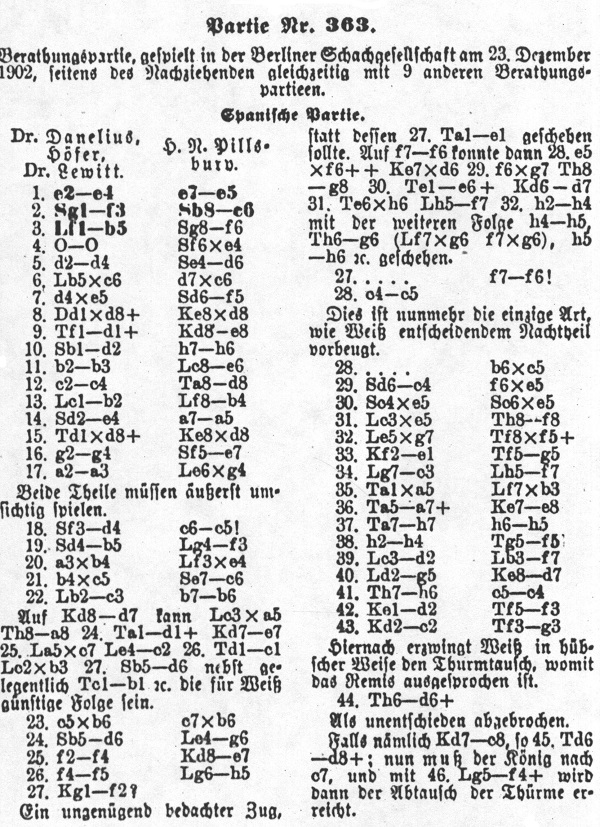
E. Schallopp’s column in the Norddeutsche Allgemeine Zeitung, 4 January 1903
Below are pages 85, 86, 98 and 99 of Akademische Schachblätter, November-December 1902:

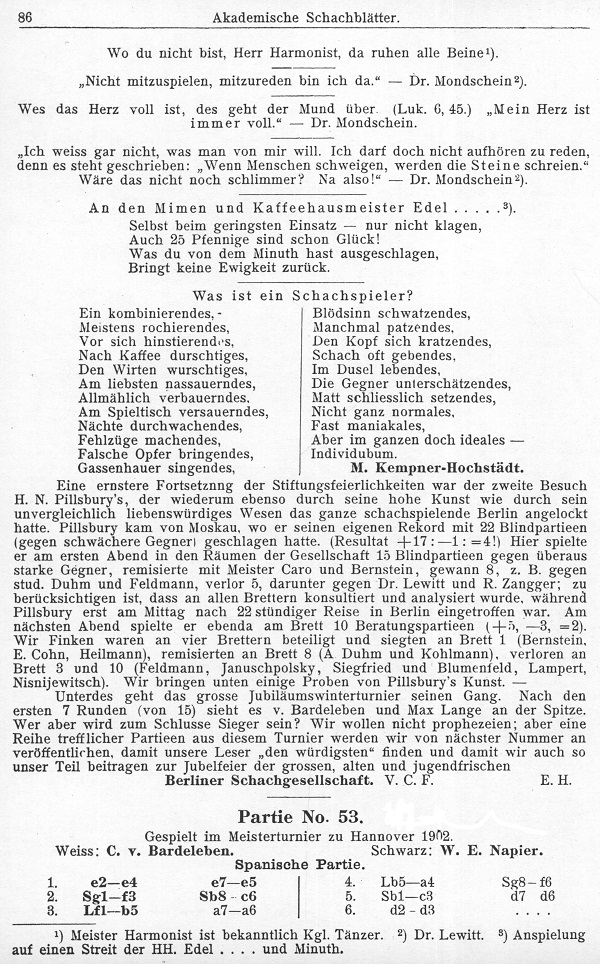

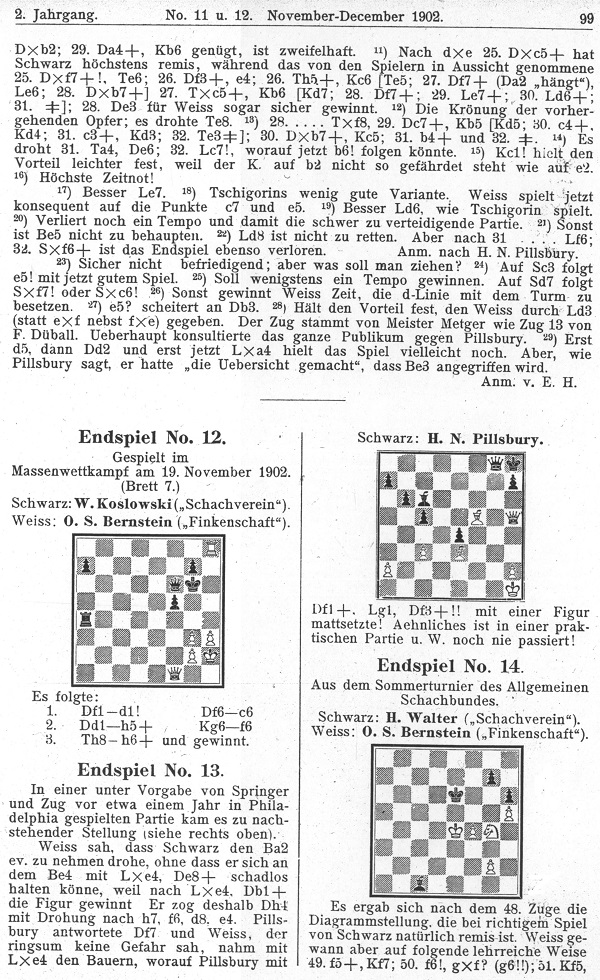
“E.H.” above is Ernst Heilmann. See also the Quarterly for Chess History 6/2000, pages 13-16, and 8/2000, pages 503-504.’
10343. Carl Walbrodt
From page 788 of the Illustrated London News, 23 November 1901:
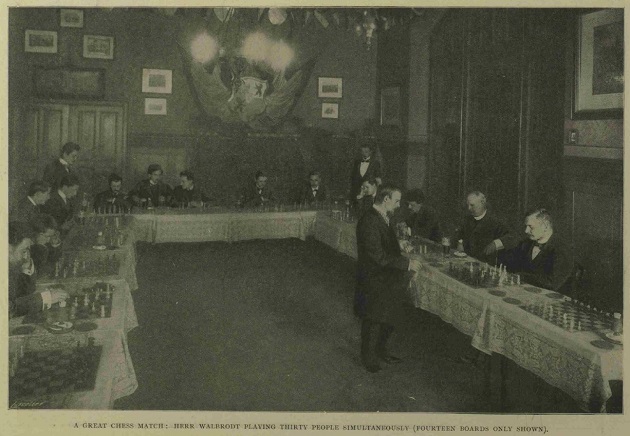
10344. Full of holes

Source: page 137 of Dynamic Chess by R.N. Coles (London, 1956). In the 1966 Dover edition, the passage is on page 135.
C.N. 2105 (see page 155 of Kings, Commoners and Knaves) asked where, if anywhere, Capablanca wrote the ‘full of holes’ remark. Reiterating the question (which remains unanswered today), C.N. 3961 added a passage by Reuben Fine that we had found on page 3 of The Chess Correspondent, May-June 1942:



From page 18 of Capablanca: A Primer of Checkmate by Frisco Del Rosario (Newton Highlands, 2010):
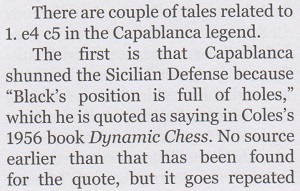
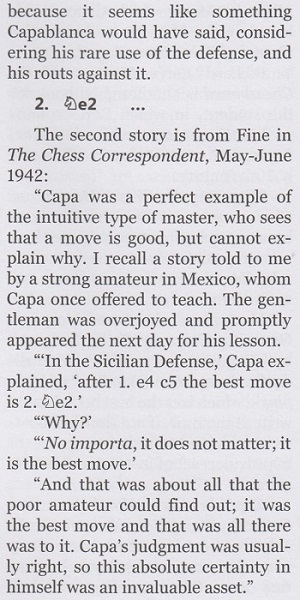
Finally, an extract from pages 40-41 of Capablanca move by move by Cyrus Lakdawala (London, 2012), in a discussion on 1 d4 f5 2 e4:


In short, Lakdawala credits Del Rosario for material which the latter lifted from C.N. 3961, and Lakdawala’s insertion of the ‘full of holes’ remark in the story of a Mexican pupil is a plain fabrication, as is his claim that Capablanca called 2 Ne2 ‘perhaps a refutation’.
10345. Larsen in Denver, 1971
Before Cyrus Lakdawala’s Capablanca move by move is returned to the shelf, a passage from page 316 may be noted:

Faulty punctuation apart, a more scrupulous publisher than Everyman Chess would have made Mr Lakdawala either verify the matter or delete the paragraph. Readers deserve better than talk of an article ‘titled something like’ and ‘a quote which went something like’.
Dan Scoones (Port Coquitlam, BC, Canada) has kindly found the article, ‘Unlucky Heat Wave’. It was published not in Canadian Chess Chat Magazine but in Chess Canada, and not in 1972 but in August 1971 (pages 17-18).
Larsen annotated the first game of his Candidates’ semi-final match against Fischer, and his opening paragraphs did indeed place heavy emphasis on the weather:
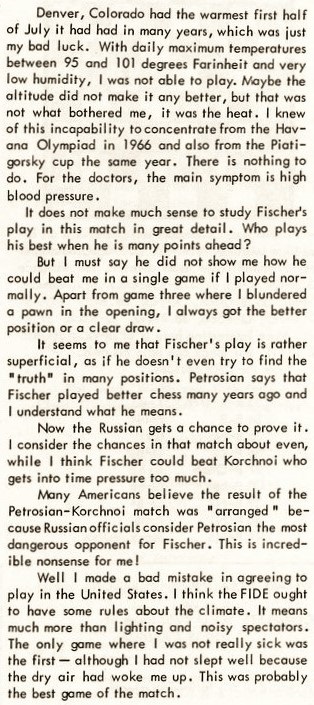
10346. Manila Interzonal, 1976
John Donaldson (Berkeley, CA, USA) provides a photograph taken during the Interzonal tournament in Manila, June-July 1976:
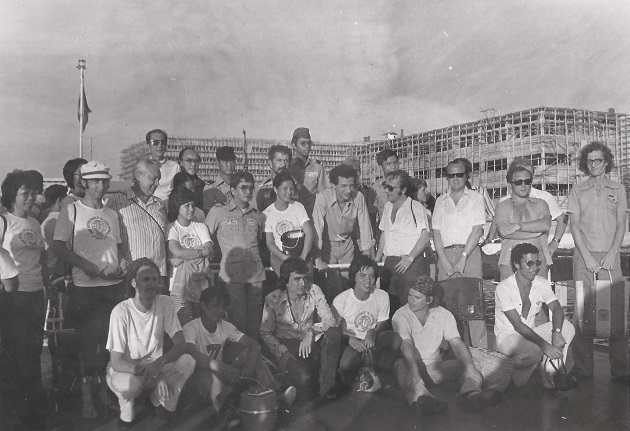
Mr Donaldson reports that with the assistance of Lubomir Kavalek, who recalls that the picture was taken after a boat trip on a free day, it has so far been possible to identify (front row, far left) John Grefe; (front row, third, fourth and fifth from the left) Khosro Harandi, Eugenio Torre and Boris Spassky; (second row, second from the left) Lubomir Kavalek; (second row, last four on the right) Florin Gheorghiu, Wolfgang Uhlmann, Vladimir Tukmakov and Orest Averkin; (back row, second from the left) Rodolfo Cardoso.
10347. Elaine Saunders
From page 17 of The People (London), 23 July 1939:

Elaine Saunders won the championship, in Bournemouth, by a two-point margin (BCM, October 1939, page 426).
10348. The last knight (C.N. 10265)
C.N. 10265 discussed descriptions of Rudolf Spielmann as ‘The Last Knight of the King’s Gambit’. From page 96 of Réti move by move by Thomas Engqvist (London, 2017):
‘In Masters of the Chess Board, Réti mentions that Spielmann was the last bard of the Gambit Game, who especially wanted to revive the King’s Gambit. Following Spielmann’s successful result at Carlsbad in 1929, where he shared second place with Capablanca and even managed to beat him, he constantly adopted 1 d4. This conversion made his colleagues nickname him not “the last knight of the King’s Gambit” but “the last knight of the Queen’s Gambit”.’
No particulars were offered.
10349. ‘Something like’ (C.N. 10345)
Chess Broadcasts on the Internet mentions commentators’ habit of saying ‘a move like Qb5’ when they mean Qb5. In chess books we now note a tendency towards ‘something like’.
10350. Highland Queen whisky (C.N. 10336)
Michael McDowell (Westcliff-on-sea, England) comments on the four problems in the Highland Queen whisky advertisements:
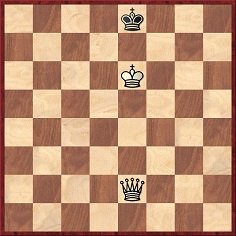
Mate in two
‘Not a sound chess problem, as 1 Qb2, 1 Qe5 and 1 Qh2 are all solutions. There are similar positions, e.g. the mate in two by E.H. Courtenay in the New York Clipper, 7 November 1868 (white king on f6, white queen on f1, black king on f8; Key: 1 Qc4). According to page 129 of Dawson and Pauly’s Christmas book Asymmetry (Stroud, 1927), Shinkman reproduced this in 1871 (no source given) and added a twin, with the white queen on f2. Key: 1 Qa7.’
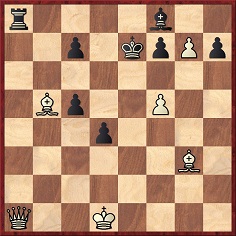
Mate in two
‘This looks like someone’s attempt to construct a game-like position featuring an underpromotion. From a problem composer’s perspective, the pieces at a8, c5 and h7 are superfluous. 1 g8(N)+ Kd8 2 Qxa8 mate.’
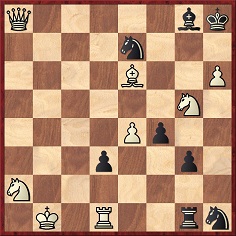
Mate in three
‘A mess. There are two solutions: 1 Qxg8+ Nxg8 2 Nf7+ and 1 Nc1, threatening 2 Qa1+.’
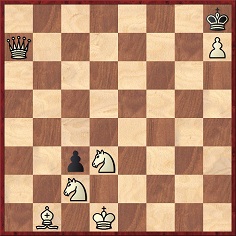
Mate in three
‘A real chess problem, by José Tolosa y Carreras, La Stratégie, 15 May 1887, page 169, but with the white king on e2 and the d3 knight on c4.’
10351. ‘National Chess Day’
Two full pages from Chess Life & Review:
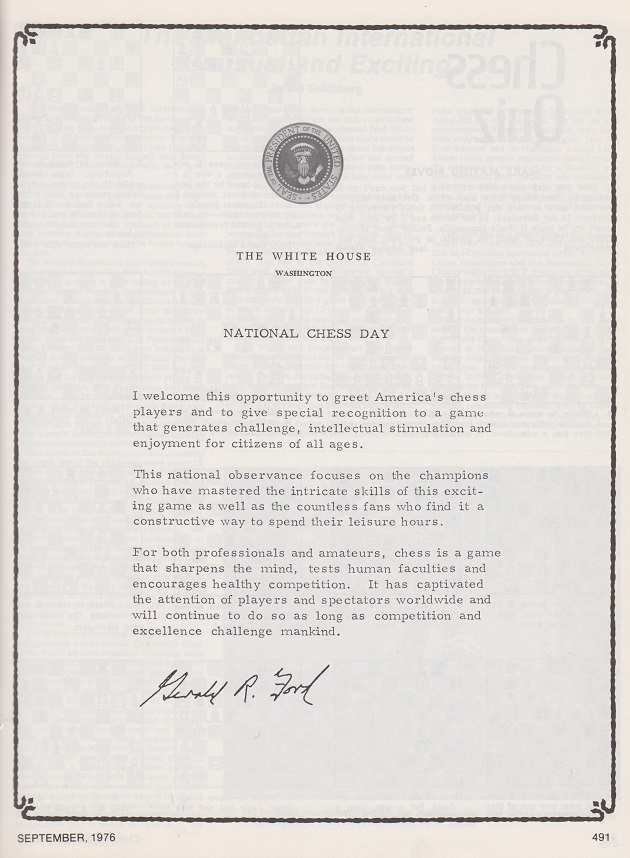
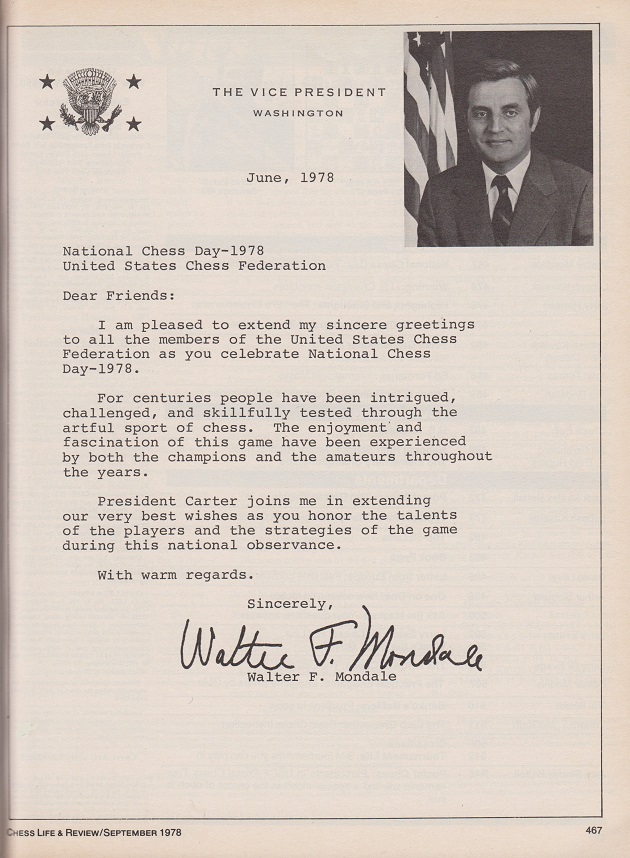
Neither message specified the date of ‘National Chess Day’.
10352. Berthold Englisch
A master who deserves more attention is Berthold Englisch (inevitably spelt ‘English’ at a number of junky websites), and some sweeping statements may firstly be noted on page 42 of How to Play Chess Like a Champion by Fred Reinfeld (New York, 1956):
‘Englisch was a player of fine capabilities, but he was dull: solid, humorless, and dull. Whereas most of us aspire to win, Englisch had one exclusive ambition: to draw. If there was any beauty in chess, it consisted in drawing a game. Just as Macbeth had to murder, Englisch had to draw. He didn’t win often – but neither did he lose often. When Englisch said, “They shall not pass!” he meant business.’
It is interesting to compare that with the feature on pages 129-130 of the January 1890 Chess Monthly, which, while remarking that ‘he always keeps the draw in hand’, depicted Englisch as a much more dynamic figure (‘the fastest player living’):

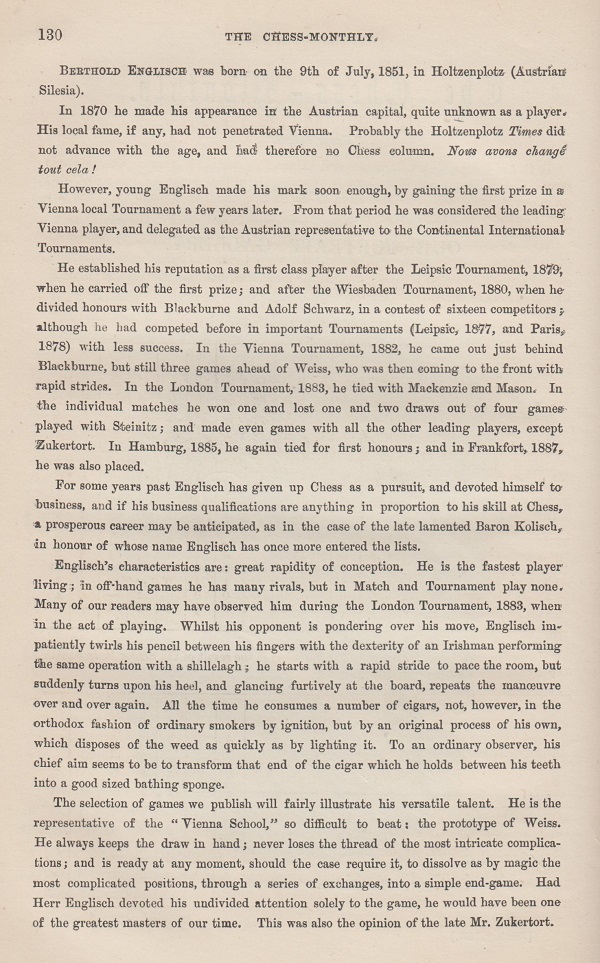
10353. Staunton’s ‘devilish bad games’ (C.N. 10293)
The Cleveland Public Library has provided the article referred to in C.N. 10293 (Evening Gazette of Cedar Rapids, Iowa, 29 December 1900, page 9):
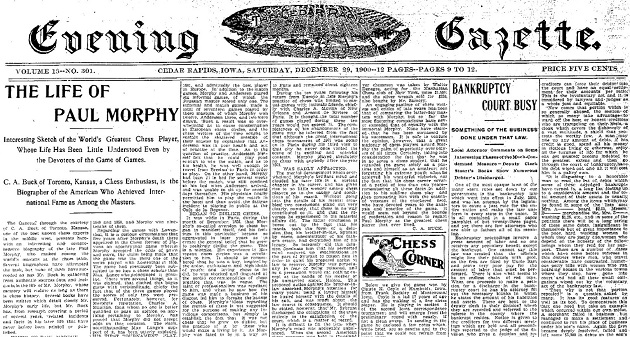
10354. Changes
An entry in The Most Famous Chess Quotations:
Siegbert Tarrasch (1862-1934)
- ‘Das Schach hat wie die Liebe, wie die Musik die Fähigkeit, den Menschen glücklich zu machen.’
Das Schachspiel by S. Tarrasch (Berlin, 1931), page 4.
- ‘Chess, like love, like music, has the power to make men happy.’
The Game of Chess by S. Tarrasch (London, 1935), page xi. Translated by G.E. Smith and T.G. Bone.
As indicated in C.N. 5823, that sentence – and, indeed, Tarrasch’s entire Preface – was omitted from the 1994 algebraic edition of The Game of Chess, edited by Lou Hays and David Sewell. C.N. 7375 gave the French translation, by R. Jouan, of Tarrasch’s celebrated observation, from page 8 of Traité pratique du jeu d’échecs (Paris, 1952): ‘Les échecs, comme l’amour, comme la musique, ont la possibilité de donner du bonheur à l’homme.’
On-line nowadays it is possible to find not only ...
‘Chess, like love, like music, has the power to make men happy’
but also ...
‘Chess, like love, like music, has the power to make people happy.’
We do not know who first amended the Smith/Bone translation, and readers will have their own views on whether the alteration is justified.
An extreme case of a leading master’s prose being altered has been pointed out in Capablanca Book Destroyed. In his 2006 edition of Chess Fundamentals Nick de Firmian’s changes included putting ‘he or she’ where Capablanca had written ‘he’. If, heaven forfend, de Firmian were let loose on Alekhine’s book on Nottingham, 1936, he would come to this note, on page 56 of the original, concerning the third-round game between Alekhine and Tylor:
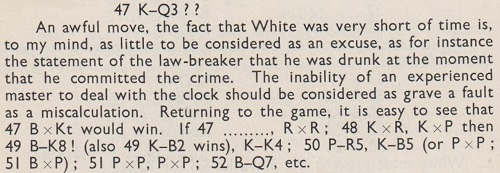
Or, in the ‘style’ imposed by de Firmian:
‘... the statement of the law-breaker that he or she was drunk at the moment that he or she committed the crime.’
10355. Men/people who will pick a pocket
The inside front cover of Chess Review, March 1952, in ‘Chernev’s Chess Corner’, had this quotation as the ‘Thought for the month’:
‘A man that will take back a move at chess will pick a pocket. – Fenton.’
Chernev also gave the comment, again without a source, on page 278 of The Chess Companion (New York, 1968).
It had appeared in a section about Richard Fenton in an article on Purssell’s chess resort on pages 230-238 of the May 1891 BCM. From pages 233-234:
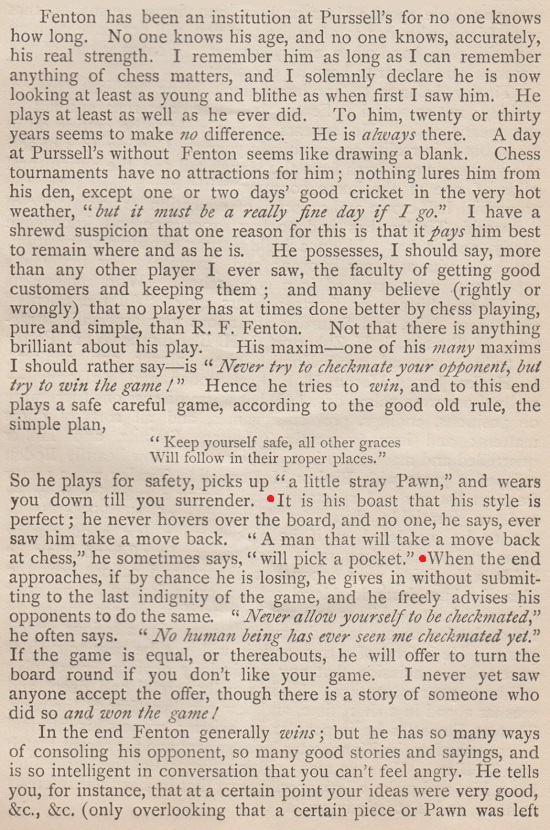

A comment-for-the-sake-of-it paragraph on page 244 of the Illustrated Sporting and Dramatic News, 30 April 1892 had a slightly different wording of the Fenton remark:

10356. A Lasker quote
From page 226 of The Tao of Chess by Peter Kurzdorfer (Avon, 2004):
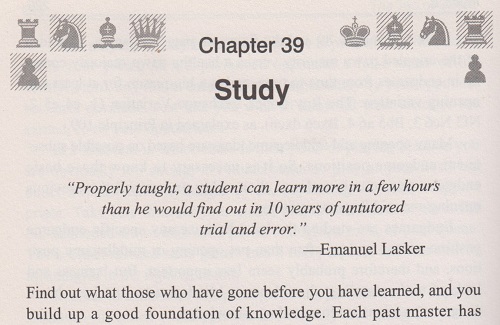
If Mr Kurzdorfer had found out what those who had gone before him had learned, he would have ascribed the quotation to Edward, not Emanuel, Lasker.
Firstly, a snippet from page 280 of Irving Chernev’s The Chess Companion:

However, on the inside front cover of Chess Review, January 1953, Chernev had correctly attributed the observation to ‘Ed. Lasker’.
The relevant passage was on page 232 of The Adventure of Chess by Edward Lasker (New York, 1950):

10357. Assiac
Christian Sánchez (Rosario, Argentina) wonders whether Assiac’s name was really ‘Heinrich L. Fraenkel’, as given by Jeremy Gaige in Chess Personalia (Jefferson, 1987), or whether there was a mix-up with Dr H.L. Frankel. Our correspondent notes the discussion of Fraenkel/Frankel in C.N.s 3244 and 3385 (see pages 205-206 of Chess Facts and Fables).
We add that in the unpublished 1994 edition of Chess Personalia the ‘L.’ was dropped by Gaige:
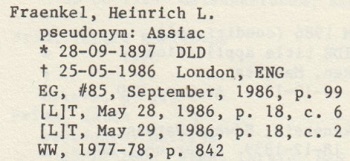
Chess Personalia (1987)
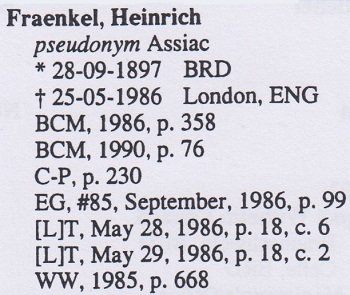
Chess Personalia (1994)
Mr Sánchez also draws attention to a webpage with biographical information about Heinrich Fraenkel.
From page 189 of CHESS, March 1968:
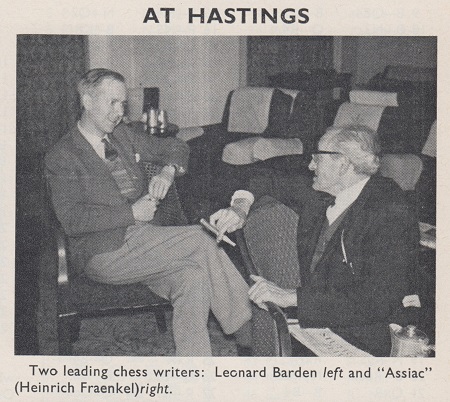
10358. H. Rinck v two amateurs
Eduardo Bauzá Mercére (New York, NY, USA) sends a game from pages 16-17 of La Stratégie, 15 January 1895:
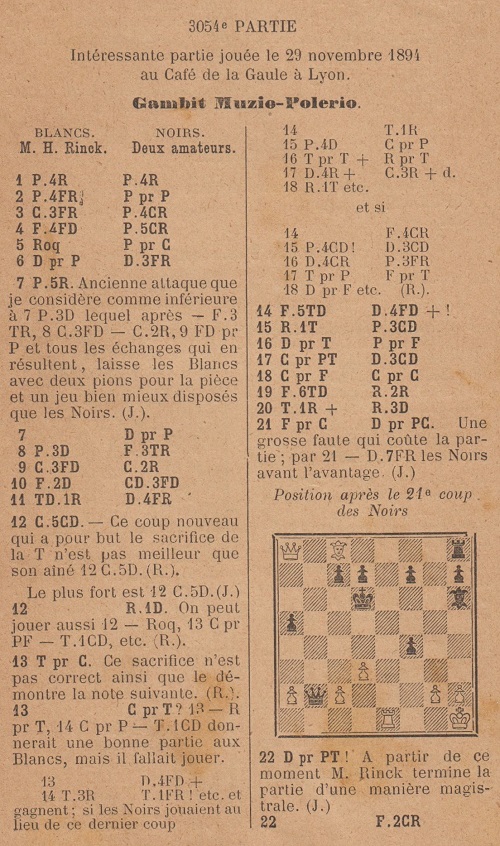
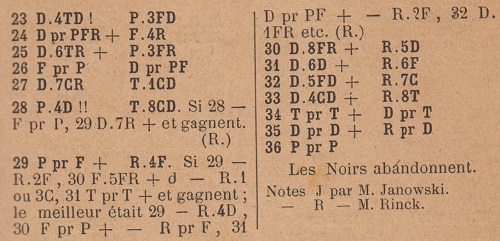
1 e4 e5 2 f4 exf4 3 Nf3 g5 4 Bc4 g4 5 O-O gxf3 6 Qxf3 Qf6 7 e5 Qxe5 8 d3 Bh6 9 Nc3 Ne7 10 Bd2 Nbc6 11 Rae1 Qf5 12 Nb5 Kd8

13 Rxe7 Nxe7 14 Ba5 Qc5+ 15 Kh1 b6 16 Qxa8 bxa5 17 Nxa7 Qb6 18 Nxc8 Nxc8 19 Ba6 Ke7 20 Re1+ Kd6 21 Bxc8 Qxb2 22 Qxa5 Bg7 23 Qa4 c6 24 Qxf4+ Be5 25 Qh6+ f6 26 Bxd7 Qxc2 27 Qg7 Rb8

28 d4 Rb1 29 dxe5+ Kc5 30 Qf8+ Kd4 31 Qd6+ Kc3 32 Qc5+ Kb2 33 Qb4+ Ka1

34 Rxb1+ Qxb1+ 35 Qxb1+ Kxb1 36 exf6 Resigns.
10359. Zonal tournament, 1957-58
A question from Ignacio Dee (Quezon City, the Philippines): is it possible to find the games played in the Zonal tournament in Baguio City (December 1957-January 1958)?
As general background information, below are the initial report published on page 249 of Chess World, December 1957 and the more detailed coverage, with corrections, on pages 5-6 of the January 1958 issue:
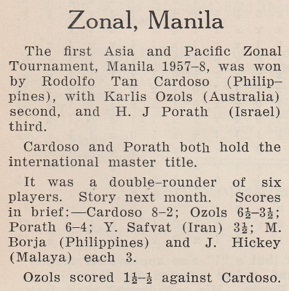


After the report by Karlis Ozols, Chess World (pages 6-8) reproduced an account by J.C. Hickey (‘an Irishman, representing Malaya’) from the Singapore Chess Bulletin and then discussed the Sonneborn scoring method in relation to the tournament.
10360. Assiac (C.N. 10357)
Ulrich Schimke (Cologne, Germany) reports that Heinrich Fraenkel’s birth certificate can be viewed online.
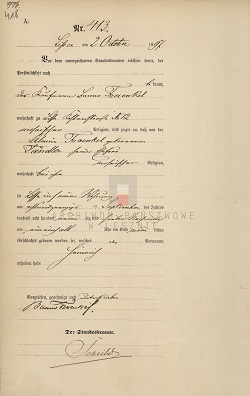
The certificate states:
‘Nr. 413
Lissa am 2. Oktober 1897
Vor dem unterzeichneten Standesbeamten erschien heute, der Persönlichkeit nach bekannt, der Kaufmann Benno Fraenkel wohnhaft zu Lissa Kostnerstraße No 12 mosaischer Religion, und zeigte an, daß von der Alwine Fraenkel geborene Tändler seiner Ehefrau mosaischer Religion, wohnhaft bei ihm zu Lissa in seiner Wohnung am achtundzwanzigsten September des Jahres tausend acht hundert neunzig und sieben Nachmittags um eineinhalb Uhr ein Kind männlichen Geschlechts geboren worden sei, welches den Vornamen Heinrich erhalten habe.
Vorgelesen, genehmigt und unterschrieben [signature of Benno Fraenkel]
Der Standesbeamte [his signature].’
10361. Spoken English
From Leonard Barden (London):
‘Heinrich (Heinz) Fraenkel had a noticeable German accent, but otherwise his spoken English was clear and grammatical. I believe, though, that his written English on non-chess subjects had a much wider vocabulary. He was quite loquacious and opinionated when he got going and was usually reluctant to end a conversation. During chess discussions he sometimes alluded to his major professional work on the Nazi leaders, but never obtrusively or in any detail. He was proud of his New Statesman column and liked to ask probing questions designed to provide new material, which did not bother my generation but sometimes irked the younger masters (especially Tony Miles) who had designs on his job.
Wolfgang Heidenfeld, who was my co-author in a book of miniatures and whom I played at least twice in tournaments, was originally German but had lived for many years in South Africa, and he had elements from both countries in his speech. He occasionally used words which echoed other German English-speakers, while his accent and tone were slightly lilting and high-pitched, like other South African players I knew, such as Kenneth Kirby.
Ernst Klein had only a slight German or Austrian accent, but he spoke in a rather clipped and brusque manner. He did not like being reminded of his pre-War roots, and asked to be called Ernest in the London, 1973 bulletin (the event discussed in C.N. 7725). I played both Jacques Mieses and Paul List, but we did not have any significant conversations. Imre König had a notably quiet speaking tone, though those who knew him later in the United States will have clearer recollections.
Dr Stefan Fazekas had a thicker accent than the others, and his English, though perfectly adequate, as it had to be since he was a GP, was both more voluble and less colloquial. It took a lot to silence him, though William Winter managed it in the British championship at Buxton in 1950 when the doctor continued playing in an ending which was clearly destined for bishop and wrong-colour rook’s pawn. It was in the evening adjournment session, around 21.45, and Winter got up from the board and said, “You can continue trying to win this, Doctor Fazekas, until the cows come home. I’m off to the pub!’ Twenty minutes later, at closing time when Winter returned and banged down his king at h8 for emphasis, Fazekas reddened and sheepishly agreed to the draw.
I knew Čenĕk Kottnauer best of all since I was a fellow competitor at Lucerne, 1952-53 when he announced his defection, as I mentioned in C.N. 8160. After he settled in London I often visited his home near Marble Arch for the excellent meals prepared by his wife Danielle and for a couple of hours of five-minute blitz. Like Fazekas, Čenĕk had quite a strong Czech accent. Although we often talked about chess matters, he preferred a succinct approach, so that I never got much out of him about, for example, the wartime tournaments in Prague and his encounters with Alekhine, Junge, and Bohatirchuk. The subject which used to set him off was Ludĕk Pachman, whom he regarded as his enemy and, along with Opočenský, behind the manoeuvres which forced him into exile from his work in the sports ministry.
My main language memory, though, is the excellent spoken English of the Dutch masters at the annual England v Holland match in the late 1950s and early 1960s. Euwe, Cortlever, van Scheltinga and, especially, Prins had good vocabularies, while the team manager and later FIDE Secretary, Hendrik J.J. Slavekoorde, was a dedicated linguist who used to quiz me every year about obscure points of syntax.’
| First column | << previous | Archives [151] | next >> | Current column |
Copyright: Edward Winter. All rights reserved.